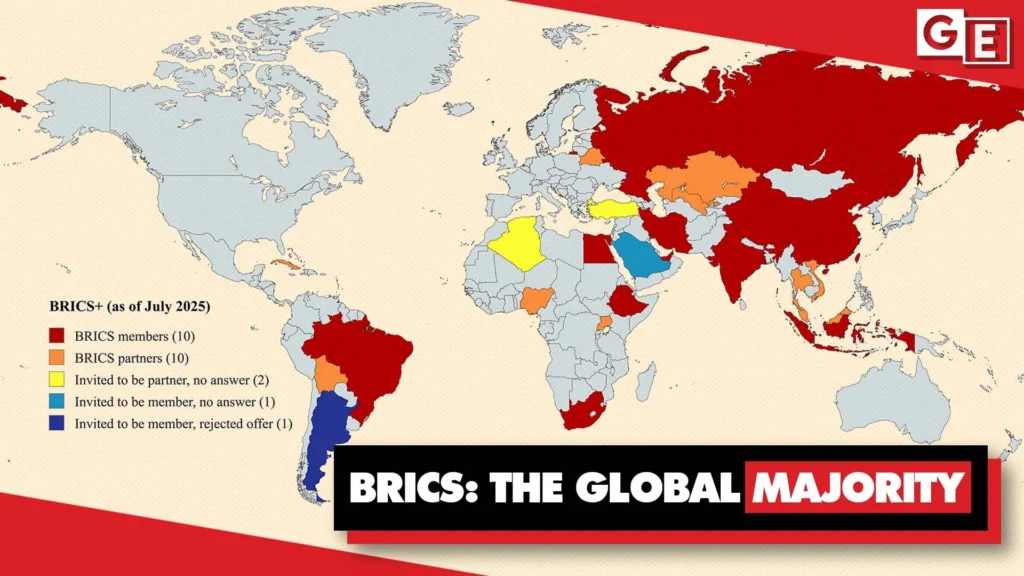BRICS Expands to 56% of World Population, 44% of Global GDP
BRICS, 7 Jul 2025
Ben Norton | Geopolitical Economy Report – TRANSCEND Media Service
4 Jul 2025 – The Global South-led organization BRICS continues to expand.
While the United States and Israel were busy waging war on Iran in June, BRICS quietly announced that Vietnam had accepted the group’s invitation to join as a partner country.
With the addition of Vietnam, the extended BRICS+ has 20 members and partners, as of July 2025.
The 10 BRICS members are Brazil, Russia, India, China, South Africa, Egypt, Ethiopia, Indonesia, Iran, and the United Arab Emirates.
The 10 BRICS partners are Belarus, Bolivia, Cuba, Kazakhstan, Malaysia, Nigeria, Thailand, Uganda, Uzbekistan, and Vietnam.
Together, the BRICS 20 make up 43.93% of the global economy, when their combined GDP is measured at purchasing power parity (PPP), according to IMF data.

The BRICS 20 have a combined population of 4.45 billion, out of a global population of 8.01 billion in 2025, based on IMF data.
This means that BRICS+ represents 55.61% of the world population.

BRICS was initially founded as BRIC – by Brazil, Russia, India, and China – in 2009. South Africa joined in 2010, and it became BRICS.
The Global South-led organization first expanded at the BRICS summit in Johannesburg, South Africa in 2023, adding new members.
At its 2024 summit in Kazan, Russia, BRICS invited a dozen more countries to join as “partner states”.
Since it has expanded, the group has frequently been referred to as BRICS+, although there is not a fixed definition of this term, and both names are used.
Vietnam had been invited to become a BRICS partner at the summit in October 2024, but it waited to accept the invitation until June 2025.
USA fails to divide China and Vietnam: Hanoi maintains non-alignment
Vietnam’s decision to join BRICS is deeply symbolic, because it reaffirms the country’s independent foreign policy and strategic non-alignment.
BRICS itself shares many commonalities with the Non-Aligned Movement, which was founded by anti-colonial Global South leaders who refused to participate in the First Cold War.
In the 21st century, the United States has sought to divide Vietnam from China, as part of the Second Cold War that Washington is waging against Beijing.
The US government plans to reroute supply chains through Vietnam to exclude China, in an example of what has been dubbed “friendshoring”.
Washington has pressured US companies to technologically “decouple” from China, to pull their investments out of the country, and to instead relocate to Vietnam.
This divide-and-conquer policy has been pursued by both the Donald Trump and Joe Biden administrations.
US Treasury Secretary Scott Bessent, a billionaire hedge fund manager from Wall Street, sought to recruit Vietnam, Japan, South Korea, and India to isolate China in what Bloomberg described as a “grand encirclement” strategy.
Vietnam, however, has adamantly resisted US efforts to sabotage its relations with China.
In fact, relations between Hanoi and Beijing have improved in recent years, following the tumultuous decades of the First Cold War and the Sino-Soviet split, when Vietnam had leaned much closer to the USSR.
China is Vietnam’s largest trading partner. The US is the second-biggest.
Donald Trump’s threat to impose high tariffs on Vietnam, whose economy depends a lot on exports to the US market, has only encouraged Hanoi and Beijing to move closer together.
Today, Vietnam promotes non-alignment, based on the policy of the “Four Nos”, which the Vietnamese government has defined as follows:
- no partaking in military alliances,
- no siding with one country to act against another,
- no foreign military bases in the Vietnamese territory or using Viet Nam as leverage to counteract other countries, and
- no using force or threatening to use force in international relations.
Despite their geopolitical differences after the Sino-Soviet split, the People’s Republic of China and Socialist Republic of Vietnam have very similar political and economic systems, especially after both carried out a market reform process.
China describes its system as a socialist market economy. Vietnam calls its system a socialist-oriented market economy.
The market-socialist models in China and Vietnam have been remarkably successful in economically developing, reducing poverty, raising incomes of the working class, and moving up the global value chain of industrial manufacturing.

_____________________________________
 Benjamin Norton is an investigative journalist, analyst, writer and filmmaker. He is the founder and editor of Multipolarista and is based in Latin America. His website: BenNorton.com (Publicaciones en español aquí.)
Benjamin Norton is an investigative journalist, analyst, writer and filmmaker. He is the founder and editor of Multipolarista and is based in Latin America. His website: BenNorton.com (Publicaciones en español aquí.)
Go to Original – geopoliticaleconomy.com
Tags: BRICS, Global South, Multipolar World Order
DISCLAIMER: The statements, views and opinions expressed in pieces republished here are solely those of the authors and do not necessarily represent those of TMS. In accordance with title 17 U.S.C. section 107, this material is distributed without profit to those who have expressed a prior interest in receiving the included information for research and educational purposes. TMS has no affiliation whatsoever with the originator of this article nor is TMS endorsed or sponsored by the originator. “GO TO ORIGINAL” links are provided as a convenience to our readers and allow for verification of authenticity. However, as originating pages are often updated by their originating host sites, the versions posted may not match the versions our readers view when clicking the “GO TO ORIGINAL” links. This site contains copyrighted material the use of which has not always been specifically authorized by the copyright owner. We are making such material available in our efforts to advance understanding of environmental, political, human rights, economic, democracy, scientific, and social justice issues, etc. We believe this constitutes a ‘fair use’ of any such copyrighted material as provided for in section 107 of the US Copyright Law. In accordance with Title 17 U.S.C. Section 107, the material on this site is distributed without profit to those who have expressed a prior interest in receiving the included information for research and educational purposes. For more information go to: http://www.law.cornell.edu/uscode/17/107.shtml. If you wish to use copyrighted material from this site for purposes of your own that go beyond ‘fair use’, you must obtain permission from the copyright owner.
Join the discussion!
We welcome debate and dissent, but personal — ad hominem — attacks (on authors, other users or any individual), abuse and defamatory language will not be tolerated. Nor will we tolerate attempts to deliberately disrupt discussions. We aim to maintain an inviting space to focus on intelligent interactions and debates.
